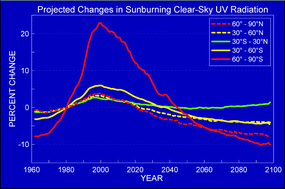The Montreal Protocol is working, but it will take several decades for ozone to return to 1980 levels. The atmospheric concentrations of ozone depleting substances are decreasing, and ozone column amounts are no longer decreasing. Mid-latitude ozone is expected to return to 1980 levels before mid-century, slightly earlier than predicted previously. However, the recovery rate will be slower at high latitudes. Springtime ozone depletion is expected to continue to occur at polar latitudes, especially in Antarctica, in the next few decades. Because of the success of the Protocol, increases in UV-B radiation have been small outside regions affected by the Antarctic ozone hole, and have been difficult to detect. There is a large variability in UV-B radiation due to factors other than ozone, such as clouds and aerosols. There are few long-term measurements available to confirm the increases that would have occurred as a result of ozone depletion. At mid-latitudes UV-B irradiances are currently only slightly greater than in 1980 (increases less than ∼5%), but increases have been substantial at high and polar latitudes where ozone depletion has been larger. Without the Montreal Protocol, peak values of sunburning UV radiation could have been tripled by 2065 at mid-northern latitudes. This would have had serious consequences for the environment and for human health. There are strong interactions between ozone depletion and changes in climate induced by increasing greenhouse gases (GHGs). Ozone depletion affects climate, and climate change affects ozone. The successful implementation of the Montreal Protocol has had a marked effect on climate change. The calculated reduction in radiative forcing due to the phase-out of chlorofluorocarbons (CFCs) far exceeds that from the measures taken under the Kyoto protocol for the reduction of GHGs. Thus the phase-out of CFCs is currently tending to counteract the increases in surface temperature due to increased GHGs. The amount of stratospheric ozone can also be affected by the increases in the concentration of GHGs, which lead to decreased temperatures in the stratosphere and accelerated circulation patterns. These changes tend to decrease total ozone in the tropics and increase total ozone at mid and high latitudes. Changes in circulation induced by changes in ozone can also affect patterns of surface wind and rainfall. The projected changes in ozone and clouds may lead to large decreases in UV at high latitudes, where UV is already low; and to small increases at low latitudes, where it is already high. This could have important implications for health and ecosystems. Compared to 1980, UV-B irradiance towards the end of the 21st century is projected to be lower at mid to high latitudes by between 5 and 20% respectively, and higher by 2–3% in the low latitudes. However, these projections must be treated with caution because they also depend strongly on changes in cloud cover, air pollutants, and aerosols, all of which are influenced by climate change, and their future is uncertain. Strong interactions between ozone depletion and climate change and uncertainties in the measurements and models limit our confidence in predicting the future UV radiation. It is therefore important to improve our understanding of the processes involved, and to continue monitoring ozone and surface UV spectral irradiances both from the surface and from satellites so we can respond to unexpected changes in the future.


 Please wait while we load your content...
Please wait while we load your content...